Impact of Mobile Banking on Customer Retention and Business Performance
VerifiedAdded on 2023/06/15
|13
|3605
|297
AI Summary
This research analyzes the impact of mobile banking on customer retention rates and business performance. It identifies the meaning and concept of mobile banking, addresses its impact on customer retention rates and business performance, and recommends strategies to improve them.
Contribute Materials
Your contribution can guide someone’s learning journey. Share your
documents today.
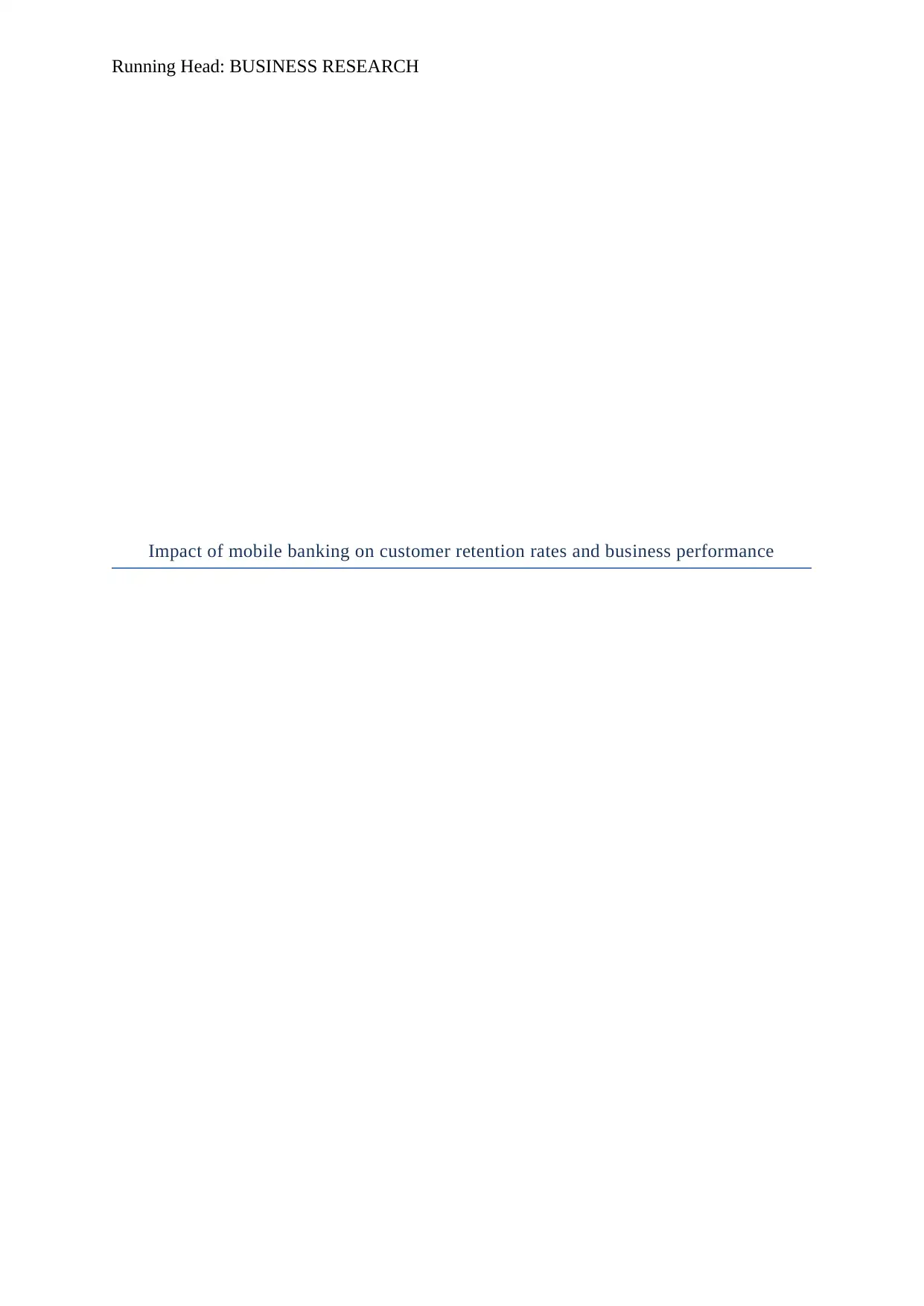
Running Head: BUSINESS RESEARCH
Impact of mobile banking on customer retention rates and business performance
Impact of mobile banking on customer retention rates and business performance
Secure Best Marks with AI Grader
Need help grading? Try our AI Grader for instant feedback on your assignments.
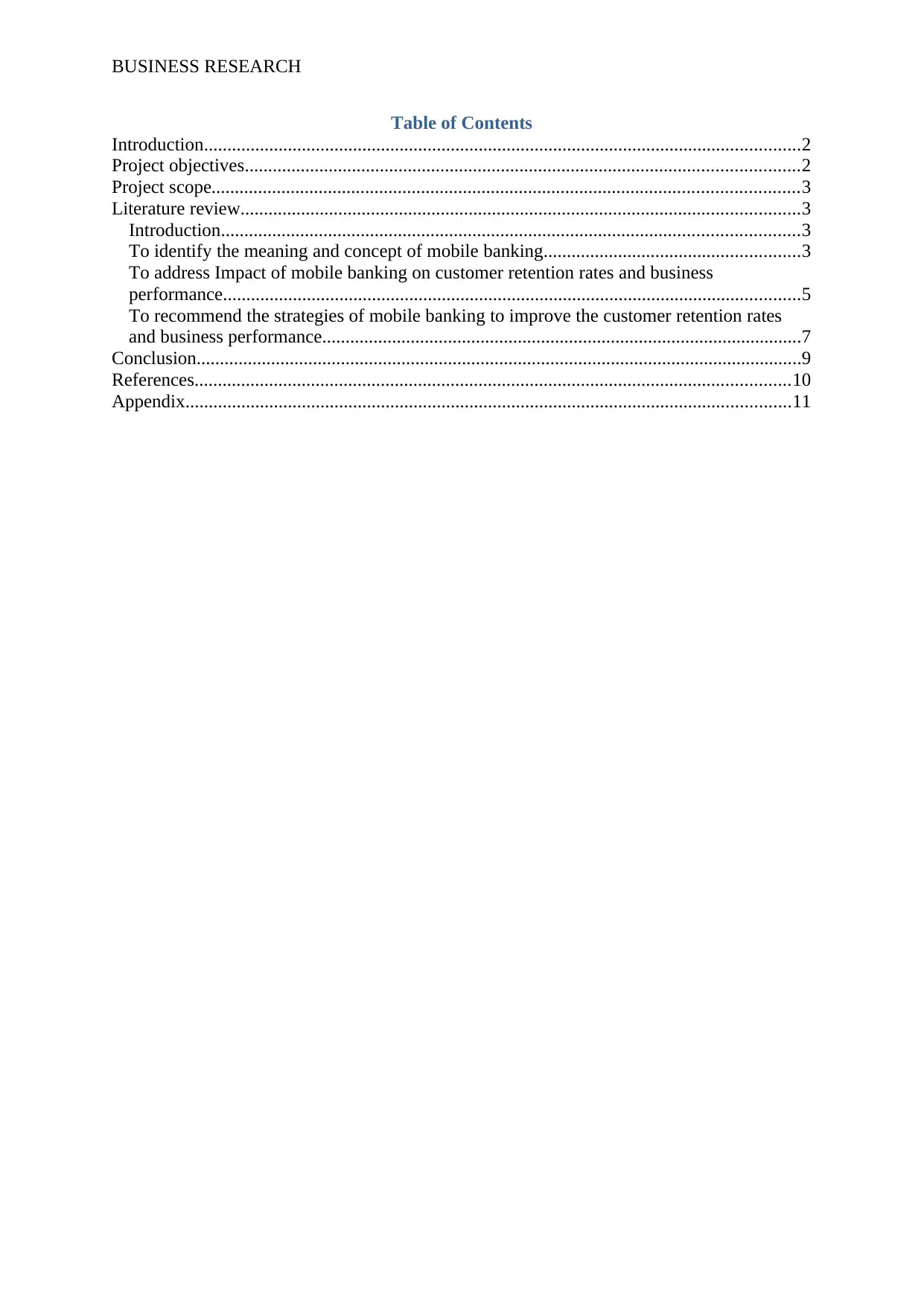
BUSINESS RESEARCH
Table of Contents
Introduction................................................................................................................................2
Project objectives.......................................................................................................................2
Project scope..............................................................................................................................3
Literature review........................................................................................................................3
Introduction............................................................................................................................3
To identify the meaning and concept of mobile banking.......................................................3
To address Impact of mobile banking on customer retention rates and business
performance............................................................................................................................5
To recommend the strategies of mobile banking to improve the customer retention rates
and business performance.......................................................................................................7
Conclusion..................................................................................................................................9
References................................................................................................................................10
Appendix..................................................................................................................................11
Table of Contents
Introduction................................................................................................................................2
Project objectives.......................................................................................................................2
Project scope..............................................................................................................................3
Literature review........................................................................................................................3
Introduction............................................................................................................................3
To identify the meaning and concept of mobile banking.......................................................3
To address Impact of mobile banking on customer retention rates and business
performance............................................................................................................................5
To recommend the strategies of mobile banking to improve the customer retention rates
and business performance.......................................................................................................7
Conclusion..................................................................................................................................9
References................................................................................................................................10
Appendix..................................................................................................................................11
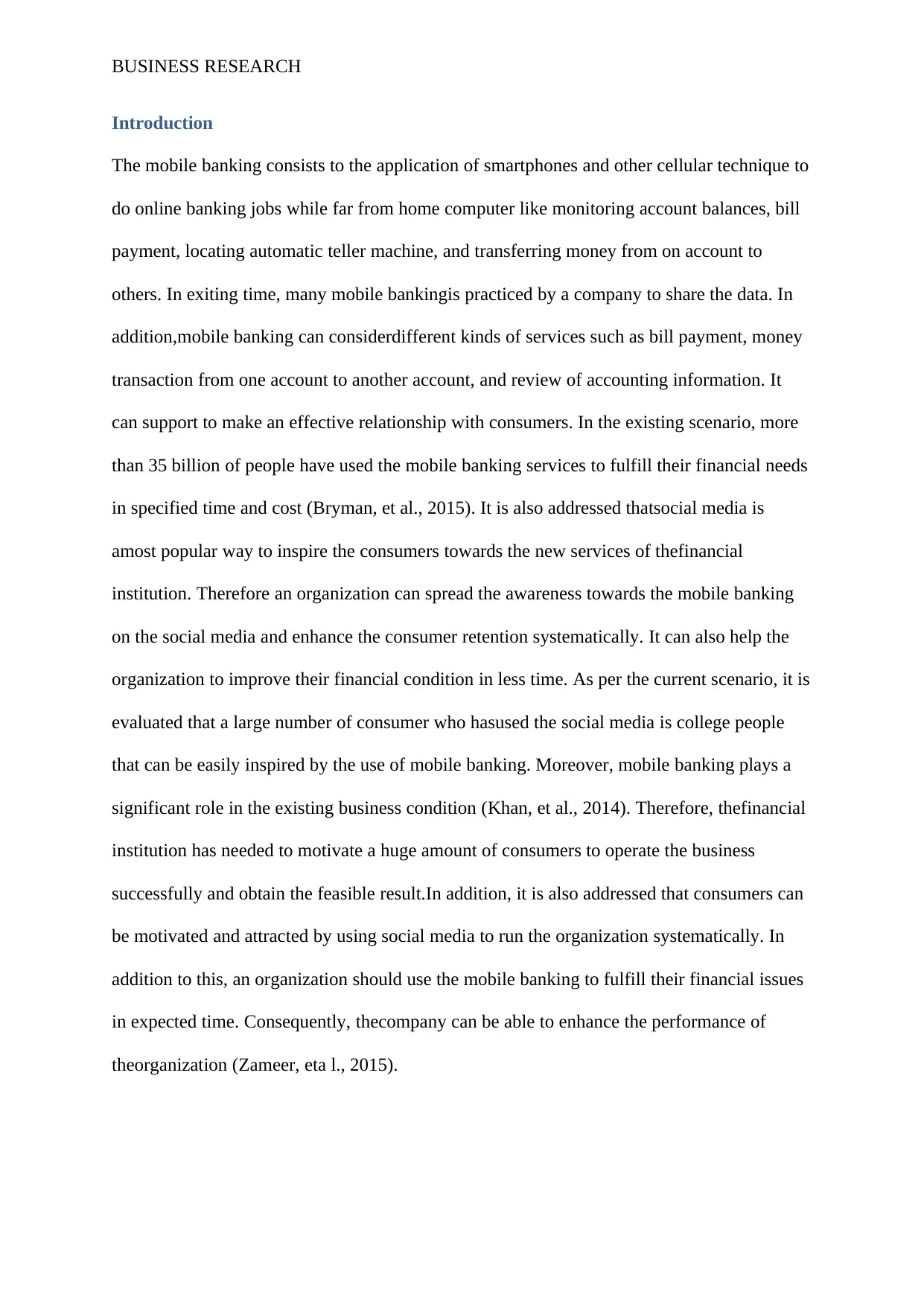
BUSINESS RESEARCH
Introduction
The mobile banking consists to the application of smartphones and other cellular technique to
do online banking jobs while far from home computer like monitoring account balances, bill
payment, locating automatic teller machine, and transferring money from on account to
others. In exiting time, many mobile bankingis practiced by a company to share the data. In
addition,mobile banking can considerdifferent kinds of services such as bill payment, money
transaction from one account to another account, and review of accounting information. It
can support to make an effective relationship with consumers. In the existing scenario, more
than 35 billion of people have used the mobile banking services to fulfill their financial needs
in specified time and cost (Bryman, et al., 2015). It is also addressed thatsocial media is
amost popular way to inspire the consumers towards the new services of thefinancial
institution. Therefore an organization can spread the awareness towards the mobile banking
on the social media and enhance the consumer retention systematically. It can also help the
organization to improve their financial condition in less time. As per the current scenario, it is
evaluated that a large number of consumer who hasused the social media is college people
that can be easily inspired by the use of mobile banking. Moreover, mobile banking plays a
significant role in the existing business condition (Khan, et al., 2014). Therefore, thefinancial
institution has needed to motivate a huge amount of consumers to operate the business
successfully and obtain the feasible result.In addition, it is also addressed that consumers can
be motivated and attracted by using social media to run the organization systematically. In
addition to this, an organization should use the mobile banking to fulfill their financial issues
in expected time. Consequently, thecompany can be able to enhance the performance of
theorganization (Zameer, eta l., 2015).
Introduction
The mobile banking consists to the application of smartphones and other cellular technique to
do online banking jobs while far from home computer like monitoring account balances, bill
payment, locating automatic teller machine, and transferring money from on account to
others. In exiting time, many mobile bankingis practiced by a company to share the data. In
addition,mobile banking can considerdifferent kinds of services such as bill payment, money
transaction from one account to another account, and review of accounting information. It
can support to make an effective relationship with consumers. In the existing scenario, more
than 35 billion of people have used the mobile banking services to fulfill their financial needs
in specified time and cost (Bryman, et al., 2015). It is also addressed thatsocial media is
amost popular way to inspire the consumers towards the new services of thefinancial
institution. Therefore an organization can spread the awareness towards the mobile banking
on the social media and enhance the consumer retention systematically. It can also help the
organization to improve their financial condition in less time. As per the current scenario, it is
evaluated that a large number of consumer who hasused the social media is college people
that can be easily inspired by the use of mobile banking. Moreover, mobile banking plays a
significant role in the existing business condition (Khan, et al., 2014). Therefore, thefinancial
institution has needed to motivate a huge amount of consumers to operate the business
successfully and obtain the feasible result.In addition, it is also addressed that consumers can
be motivated and attracted by using social media to run the organization systematically. In
addition to this, an organization should use the mobile banking to fulfill their financial issues
in expected time. Consequently, thecompany can be able to enhance the performance of
theorganization (Zameer, eta l., 2015).
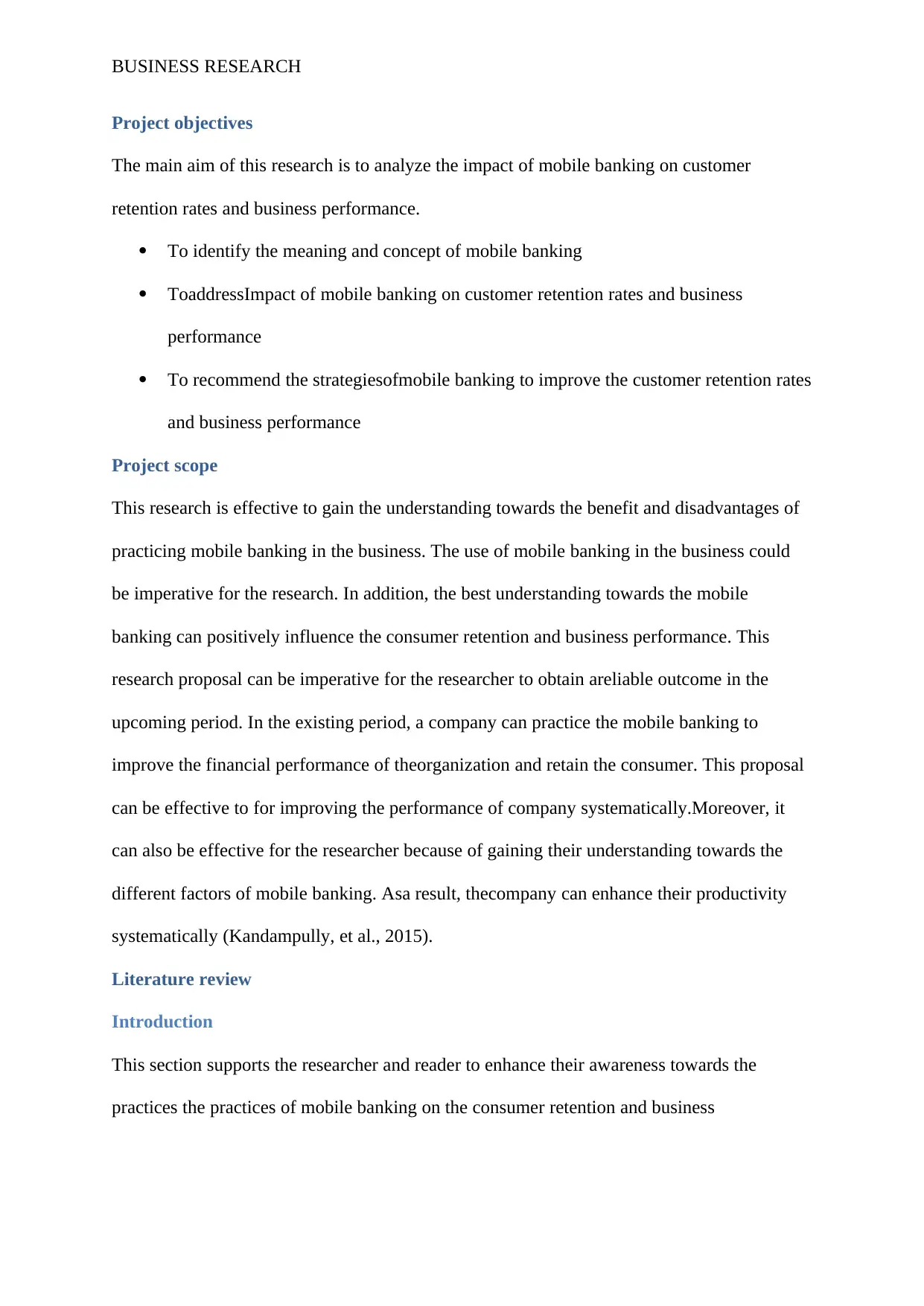
BUSINESS RESEARCH
Project objectives
The main aim of this research is to analyze the impact of mobile banking on customer
retention rates and business performance.
To identify the meaning and concept of mobile banking
ToaddressImpact of mobile banking on customer retention rates and business
performance
To recommend the strategiesofmobile banking to improve the customer retention rates
and business performance
Project scope
This research is effective to gain the understanding towards the benefit and disadvantages of
practicing mobile banking in the business. The use of mobile banking in the business could
be imperative for the research. In addition, the best understanding towards the mobile
banking can positively influence the consumer retention and business performance. This
research proposal can be imperative for the researcher to obtain areliable outcome in the
upcoming period. In the existing period, a company can practice the mobile banking to
improve the financial performance of theorganization and retain the consumer. This proposal
can be effective to for improving the performance of company systematically.Moreover, it
can also be effective for the researcher because of gaining their understanding towards the
different factors of mobile banking. Asa result, thecompany can enhance their productivity
systematically (Kandampully, et al., 2015).
Literature review
Introduction
This section supports the researcher and reader to enhance their awareness towards the
practices the practices of mobile banking on the consumer retention and business
Project objectives
The main aim of this research is to analyze the impact of mobile banking on customer
retention rates and business performance.
To identify the meaning and concept of mobile banking
ToaddressImpact of mobile banking on customer retention rates and business
performance
To recommend the strategiesofmobile banking to improve the customer retention rates
and business performance
Project scope
This research is effective to gain the understanding towards the benefit and disadvantages of
practicing mobile banking in the business. The use of mobile banking in the business could
be imperative for the research. In addition, the best understanding towards the mobile
banking can positively influence the consumer retention and business performance. This
research proposal can be imperative for the researcher to obtain areliable outcome in the
upcoming period. In the existing period, a company can practice the mobile banking to
improve the financial performance of theorganization and retain the consumer. This proposal
can be effective to for improving the performance of company systematically.Moreover, it
can also be effective for the researcher because of gaining their understanding towards the
different factors of mobile banking. Asa result, thecompany can enhance their productivity
systematically (Kandampully, et al., 2015).
Literature review
Introduction
This section supports the researcher and reader to enhance their awareness towards the
practices the practices of mobile banking on the consumer retention and business
Secure Best Marks with AI Grader
Need help grading? Try our AI Grader for instant feedback on your assignments.
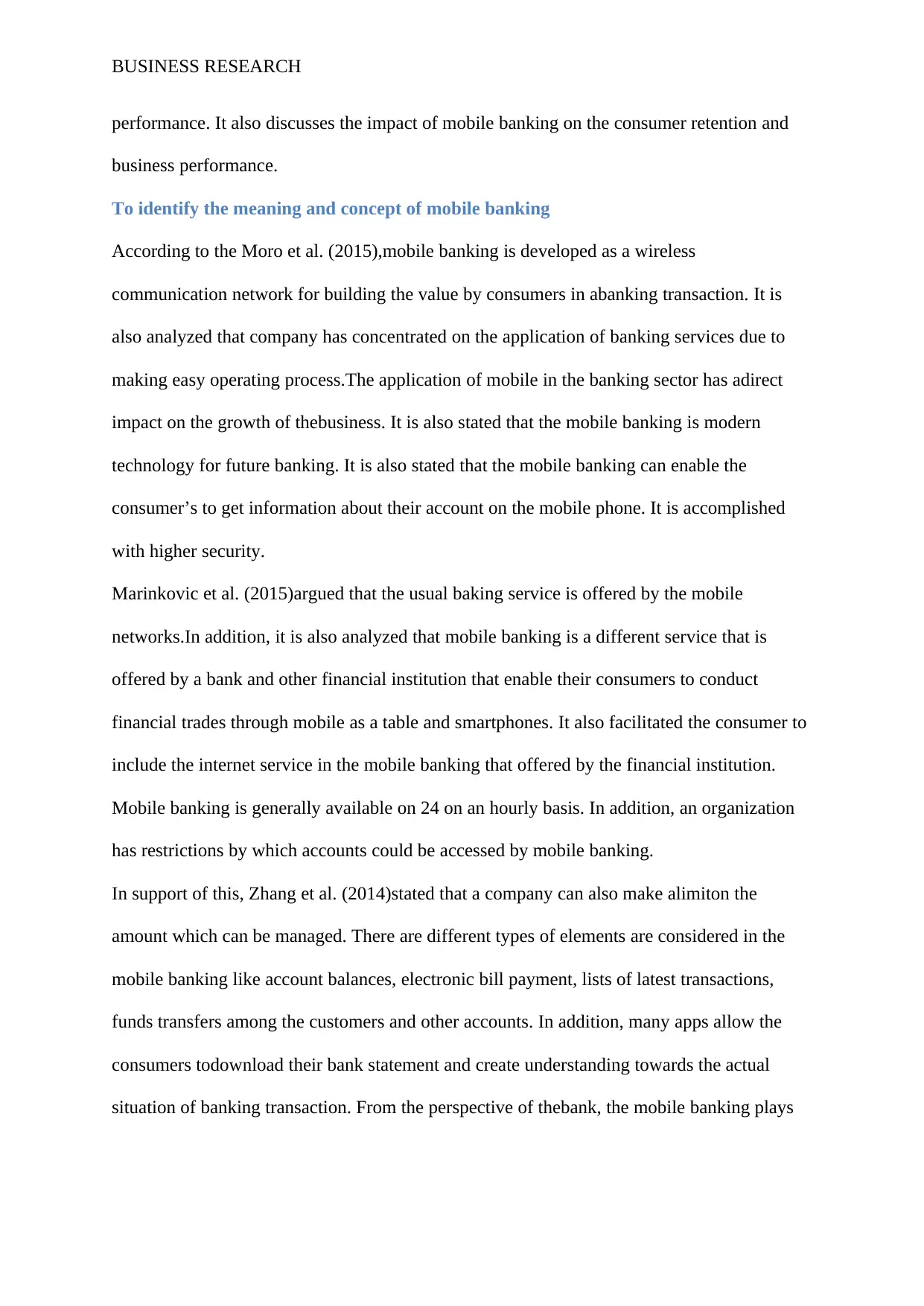
BUSINESS RESEARCH
performance. It also discusses the impact of mobile banking on the consumer retention and
business performance.
To identify the meaning and concept of mobile banking
According to the Moro et al. (2015),mobile banking is developed as a wireless
communication network for building the value by consumers in abanking transaction. It is
also analyzed that company has concentrated on the application of banking services due to
making easy operating process.The application of mobile in the banking sector has adirect
impact on the growth of thebusiness. It is also stated that the mobile banking is modern
technology for future banking. It is also stated that the mobile banking can enable the
consumer’s to get information about their account on the mobile phone. It is accomplished
with higher security.
Marinkovic et al. (2015)argued that the usual baking service is offered by the mobile
networks.In addition, it is also analyzed that mobile banking is a different service that is
offered by a bank and other financial institution that enable their consumers to conduct
financial trades through mobile as a table and smartphones. It also facilitated the consumer to
include the internet service in the mobile banking that offered by the financial institution.
Mobile banking is generally available on 24 on an hourly basis. In addition, an organization
has restrictions by which accounts could be accessed by mobile banking.
In support of this, Zhang et al. (2014)stated that a company can also make alimiton the
amount which can be managed. There are different types of elements are considered in the
mobile banking like account balances, electronic bill payment, lists of latest transactions,
funds transfers among the customers and other accounts. In addition, many apps allow the
consumers todownload their bank statement and create understanding towards the actual
situation of banking transaction. From the perspective of thebank, the mobile banking plays
performance. It also discusses the impact of mobile banking on the consumer retention and
business performance.
To identify the meaning and concept of mobile banking
According to the Moro et al. (2015),mobile banking is developed as a wireless
communication network for building the value by consumers in abanking transaction. It is
also analyzed that company has concentrated on the application of banking services due to
making easy operating process.The application of mobile in the banking sector has adirect
impact on the growth of thebusiness. It is also stated that the mobile banking is modern
technology for future banking. It is also stated that the mobile banking can enable the
consumer’s to get information about their account on the mobile phone. It is accomplished
with higher security.
Marinkovic et al. (2015)argued that the usual baking service is offered by the mobile
networks.In addition, it is also analyzed that mobile banking is a different service that is
offered by a bank and other financial institution that enable their consumers to conduct
financial trades through mobile as a table and smartphones. It also facilitated the consumer to
include the internet service in the mobile banking that offered by the financial institution.
Mobile banking is generally available on 24 on an hourly basis. In addition, an organization
has restrictions by which accounts could be accessed by mobile banking.
In support of this, Zhang et al. (2014)stated that a company can also make alimiton the
amount which can be managed. There are different types of elements are considered in the
mobile banking like account balances, electronic bill payment, lists of latest transactions,
funds transfers among the customers and other accounts. In addition, many apps allow the
consumers todownload their bank statement and create understanding towards the actual
situation of banking transaction. From the perspective of thebank, the mobile banking plays
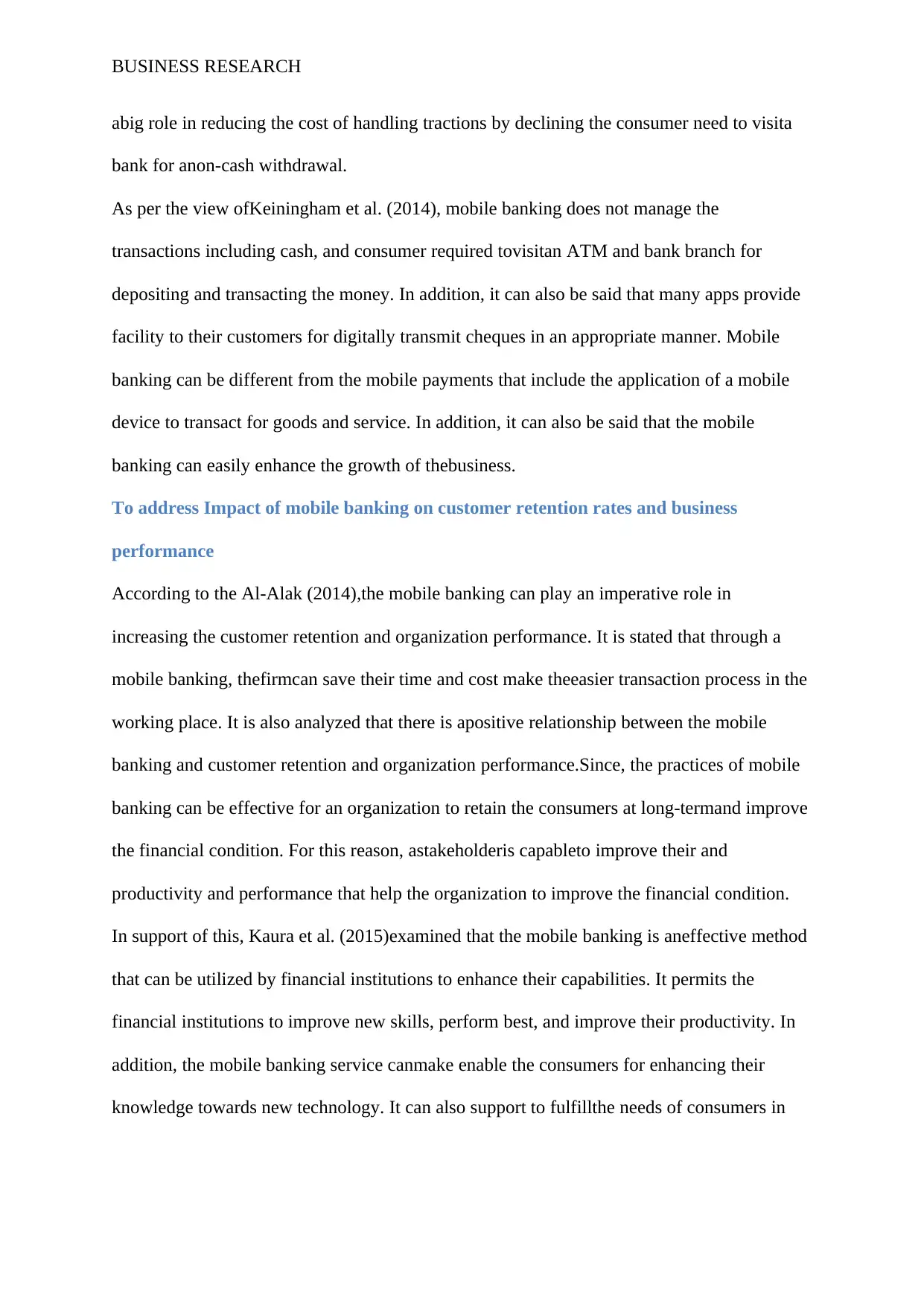
BUSINESS RESEARCH
abig role in reducing the cost of handling tractions by declining the consumer need to visita
bank for anon-cash withdrawal.
As per the view ofKeiningham et al. (2014), mobile banking does not manage the
transactions including cash, and consumer required tovisitan ATM and bank branch for
depositing and transacting the money. In addition, it can also be said that many apps provide
facility to their customers for digitally transmit cheques in an appropriate manner. Mobile
banking can be different from the mobile payments that include the application of a mobile
device to transact for goods and service. In addition, it can also be said that the mobile
banking can easily enhance the growth of thebusiness.
To address Impact of mobile banking on customer retention rates and business
performance
According to the Al-Alak (2014),the mobile banking can play an imperative role in
increasing the customer retention and organization performance. It is stated that through a
mobile banking, thefirmcan save their time and cost make theeasier transaction process in the
working place. It is also analyzed that there is apositive relationship between the mobile
banking and customer retention and organization performance.Since, the practices of mobile
banking can be effective for an organization to retain the consumers at long-termand improve
the financial condition. For this reason, astakeholderis capableto improve their and
productivity and performance that help the organization to improve the financial condition.
In support of this, Kaura et al. (2015)examined that the mobile banking is aneffective method
that can be utilized by financial institutions to enhance their capabilities. It permits the
financial institutions to improve new skills, perform best, and improve their productivity. In
addition, the mobile banking service canmake enable the consumers for enhancing their
knowledge towards new technology. It can also support to fulfillthe needs of consumers in
abig role in reducing the cost of handling tractions by declining the consumer need to visita
bank for anon-cash withdrawal.
As per the view ofKeiningham et al. (2014), mobile banking does not manage the
transactions including cash, and consumer required tovisitan ATM and bank branch for
depositing and transacting the money. In addition, it can also be said that many apps provide
facility to their customers for digitally transmit cheques in an appropriate manner. Mobile
banking can be different from the mobile payments that include the application of a mobile
device to transact for goods and service. In addition, it can also be said that the mobile
banking can easily enhance the growth of thebusiness.
To address Impact of mobile banking on customer retention rates and business
performance
According to the Al-Alak (2014),the mobile banking can play an imperative role in
increasing the customer retention and organization performance. It is stated that through a
mobile banking, thefirmcan save their time and cost make theeasier transaction process in the
working place. It is also analyzed that there is apositive relationship between the mobile
banking and customer retention and organization performance.Since, the practices of mobile
banking can be effective for an organization to retain the consumers at long-termand improve
the financial condition. For this reason, astakeholderis capableto improve their and
productivity and performance that help the organization to improve the financial condition.
In support of this, Kaura et al. (2015)examined that the mobile banking is aneffective method
that can be utilized by financial institutions to enhance their capabilities. It permits the
financial institutions to improve new skills, perform best, and improve their productivity. In
addition, the mobile banking service canmake enable the consumers for enhancing their
knowledge towards new technology. It can also support to fulfillthe needs of consumers in
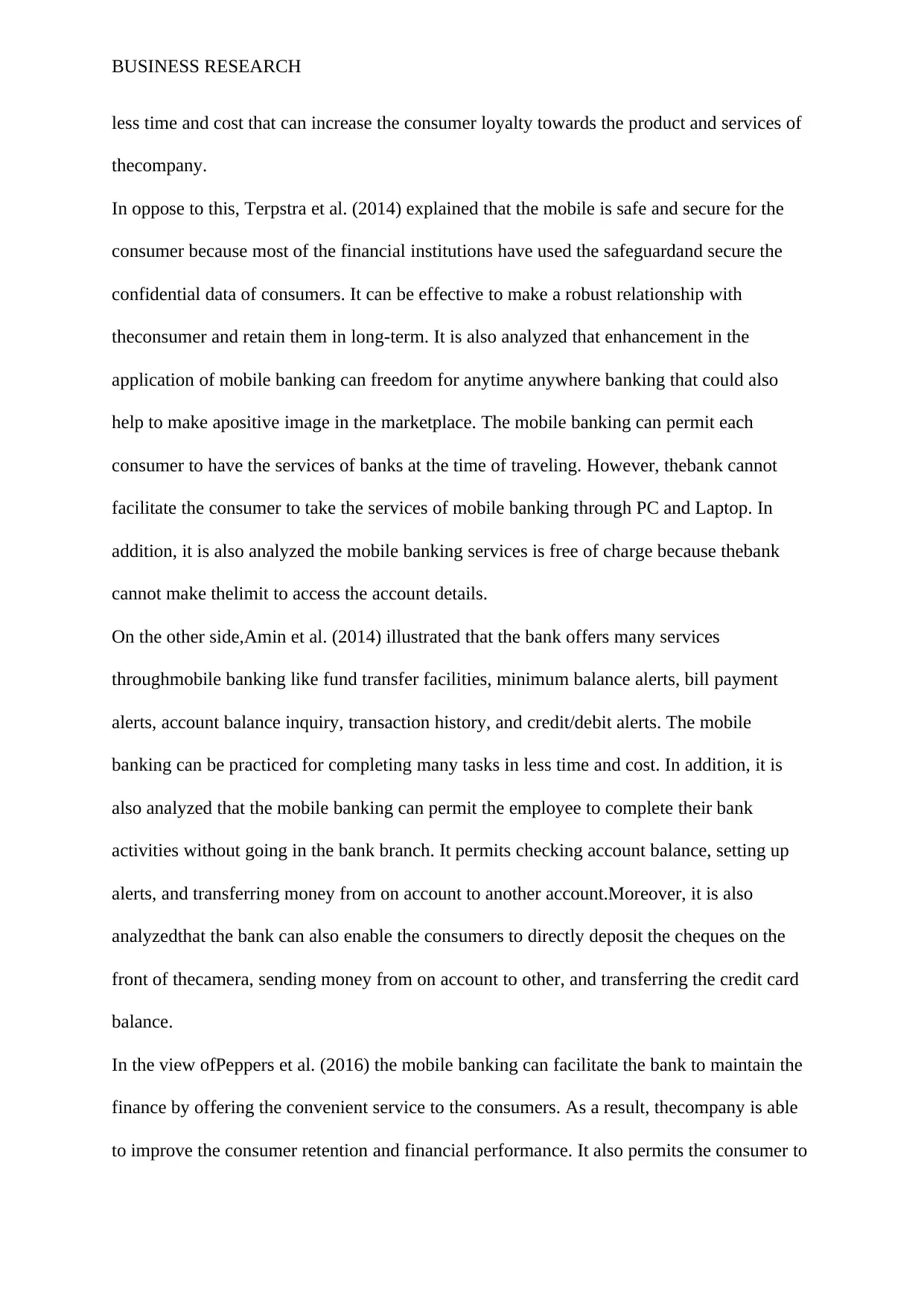
BUSINESS RESEARCH
less time and cost that can increase the consumer loyalty towards the product and services of
thecompany.
In oppose to this, Terpstra et al. (2014) explained that the mobile is safe and secure for the
consumer because most of the financial institutions have used the safeguardand secure the
confidential data of consumers. It can be effective to make a robust relationship with
theconsumer and retain them in long-term. It is also analyzed that enhancement in the
application of mobile banking can freedom for anytime anywhere banking that could also
help to make apositive image in the marketplace. The mobile banking can permit each
consumer to have the services of banks at the time of traveling. However, thebank cannot
facilitate the consumer to take the services of mobile banking through PC and Laptop. In
addition, it is also analyzed the mobile banking services is free of charge because thebank
cannot make thelimit to access the account details.
On the other side,Amin et al. (2014) illustrated that the bank offers many services
throughmobile banking like fund transfer facilities, minimum balance alerts, bill payment
alerts, account balance inquiry, transaction history, and credit/debit alerts. The mobile
banking can be practiced for completing many tasks in less time and cost. In addition, it is
also analyzed that the mobile banking can permit the employee to complete their bank
activities without going in the bank branch. It permits checking account balance, setting up
alerts, and transferring money from on account to another account.Moreover, it is also
analyzedthat the bank can also enable the consumers to directly deposit the cheques on the
front of thecamera, sending money from on account to other, and transferring the credit card
balance.
In the view ofPeppers et al. (2016) the mobile banking can facilitate the bank to maintain the
finance by offering the convenient service to the consumers. As a result, thecompany is able
to improve the consumer retention and financial performance. It also permits the consumer to
less time and cost that can increase the consumer loyalty towards the product and services of
thecompany.
In oppose to this, Terpstra et al. (2014) explained that the mobile is safe and secure for the
consumer because most of the financial institutions have used the safeguardand secure the
confidential data of consumers. It can be effective to make a robust relationship with
theconsumer and retain them in long-term. It is also analyzed that enhancement in the
application of mobile banking can freedom for anytime anywhere banking that could also
help to make apositive image in the marketplace. The mobile banking can permit each
consumer to have the services of banks at the time of traveling. However, thebank cannot
facilitate the consumer to take the services of mobile banking through PC and Laptop. In
addition, it is also analyzed the mobile banking services is free of charge because thebank
cannot make thelimit to access the account details.
On the other side,Amin et al. (2014) illustrated that the bank offers many services
throughmobile banking like fund transfer facilities, minimum balance alerts, bill payment
alerts, account balance inquiry, transaction history, and credit/debit alerts. The mobile
banking can be practiced for completing many tasks in less time and cost. In addition, it is
also analyzed that the mobile banking can permit the employee to complete their bank
activities without going in the bank branch. It permits checking account balance, setting up
alerts, and transferring money from on account to another account.Moreover, it is also
analyzedthat the bank can also enable the consumers to directly deposit the cheques on the
front of thecamera, sending money from on account to other, and transferring the credit card
balance.
In the view ofPeppers et al. (2016) the mobile banking can facilitate the bank to maintain the
finance by offering the convenient service to the consumers. As a result, thecompany is able
to improve the consumer retention and financial performance. It also permits the consumer to
Paraphrase This Document
Need a fresh take? Get an instant paraphrase of this document with our AI Paraphraser

BUSINESS RESEARCH
review their balance and always understand their financial condition.A customer can instantly
deposit the check and get the cash in less time. It can also retain the consumer and improve
the performance of theorganization. It also facilitated that employee to pay the bill before
going anywhere and save time and cost of theorganization as well as theconsumer. As a
result, anorganization can make adifferent image in the marketplace and enhance the
consumer retention that will positivelyimpact the performance of theorganization. All such
features can permit the consumer to control the money on time.It is also stated that does not
matter where you are, it provides the service at anytime and anywhere. Bank branches can
handle the financial transaction activity of consumers in the specified time. However, the
mobile banking facilitated the consumers to have the service 24*7.
On the other side,Tingchi et al. (2014)the younger age of people are generally keen to address
their fund flow statement via mobile. It is also stated that 58% of 26-35 years old and 52% of
18-24 years of consumers have used the smartphones. In addition to this, it can also be said
that the smartphone is an effective way to access banking service for both age group of
people. In the current era, most of the person has believed on the social media so in case any
wrong information spreads on the social media then it can negative impact on the growth of
theorganization. Hence, an organization has needed to focus on such kinds of issues due to
effectively deal with theunexpected situation and sustain in the marketplace for long-term.
To recommend the strategies of mobile banking to improve the customer retention rates
and business performance
In the view of this, Kumar (2015)financial institution should provide the mobile apps to their
consumers for solving their financial issues in less cost and time. In addition, it is also stated
that an effective mobile app can only take care the consumers. The apps should function
beyond the expectation of consumer due to attracting a large number of consumers in less
time. Moreover, an organization app should transfer the fund and fulfill the basic important
review their balance and always understand their financial condition.A customer can instantly
deposit the check and get the cash in less time. It can also retain the consumer and improve
the performance of theorganization. It also facilitated that employee to pay the bill before
going anywhere and save time and cost of theorganization as well as theconsumer. As a
result, anorganization can make adifferent image in the marketplace and enhance the
consumer retention that will positivelyimpact the performance of theorganization. All such
features can permit the consumer to control the money on time.It is also stated that does not
matter where you are, it provides the service at anytime and anywhere. Bank branches can
handle the financial transaction activity of consumers in the specified time. However, the
mobile banking facilitated the consumers to have the service 24*7.
On the other side,Tingchi et al. (2014)the younger age of people are generally keen to address
their fund flow statement via mobile. It is also stated that 58% of 26-35 years old and 52% of
18-24 years of consumers have used the smartphones. In addition to this, it can also be said
that the smartphone is an effective way to access banking service for both age group of
people. In the current era, most of the person has believed on the social media so in case any
wrong information spreads on the social media then it can negative impact on the growth of
theorganization. Hence, an organization has needed to focus on such kinds of issues due to
effectively deal with theunexpected situation and sustain in the marketplace for long-term.
To recommend the strategies of mobile banking to improve the customer retention rates
and business performance
In the view of this, Kumar (2015)financial institution should provide the mobile apps to their
consumers for solving their financial issues in less cost and time. In addition, it is also stated
that an effective mobile app can only take care the consumers. The apps should function
beyond the expectation of consumer due to attracting a large number of consumers in less
time. Moreover, an organization app should transfer the fund and fulfill the basic important
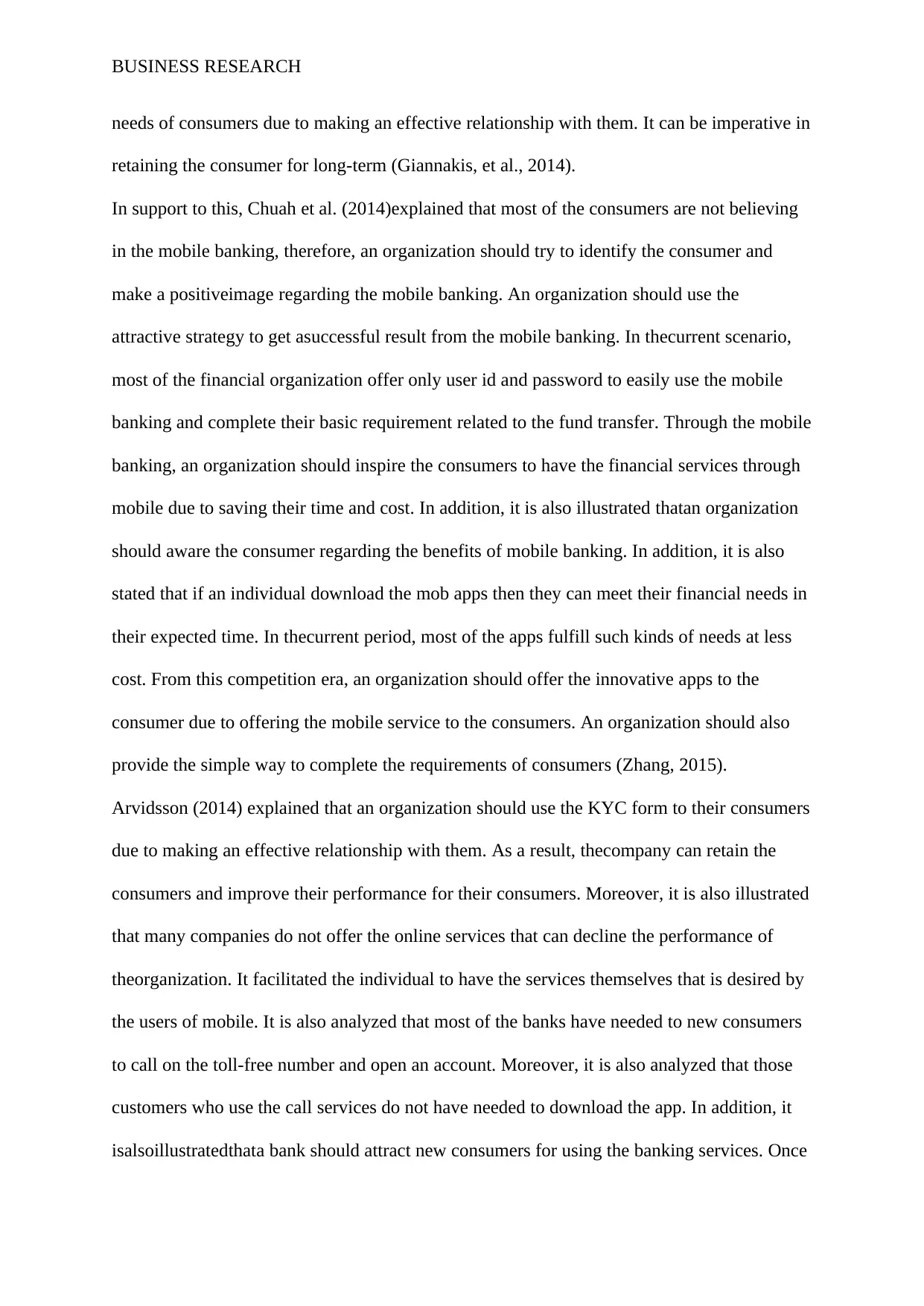
BUSINESS RESEARCH
needs of consumers due to making an effective relationship with them. It can be imperative in
retaining the consumer for long-term (Giannakis, et al., 2014).
In support to this, Chuah et al. (2014)explained that most of the consumers are not believing
in the mobile banking, therefore, an organization should try to identify the consumer and
make a positiveimage regarding the mobile banking. An organization should use the
attractive strategy to get asuccessful result from the mobile banking. In thecurrent scenario,
most of the financial organization offer only user id and password to easily use the mobile
banking and complete their basic requirement related to the fund transfer. Through the mobile
banking, an organization should inspire the consumers to have the financial services through
mobile due to saving their time and cost. In addition, it is also illustrated thatan organization
should aware the consumer regarding the benefits of mobile banking. In addition, it is also
stated that if an individual download the mob apps then they can meet their financial needs in
their expected time. In thecurrent period, most of the apps fulfill such kinds of needs at less
cost. From this competition era, an organization should offer the innovative apps to the
consumer due to offering the mobile service to the consumers. An organization should also
provide the simple way to complete the requirements of consumers (Zhang, 2015).
Arvidsson (2014) explained that an organization should use the KYC form to their consumers
due to making an effective relationship with them. As a result, thecompany can retain the
consumers and improve their performance for their consumers. Moreover, it is also illustrated
that many companies do not offer the online services that can decline the performance of
theorganization. It facilitated the individual to have the services themselves that is desired by
the users of mobile. It is also analyzed that most of the banks have needed to new consumers
to call on the toll-free number and open an account. Moreover, it is also analyzed that those
customers who use the call services do not have needed to download the app. In addition, it
isalsoillustratedthata bank should attract new consumers for using the banking services. Once
needs of consumers due to making an effective relationship with them. It can be imperative in
retaining the consumer for long-term (Giannakis, et al., 2014).
In support to this, Chuah et al. (2014)explained that most of the consumers are not believing
in the mobile banking, therefore, an organization should try to identify the consumer and
make a positiveimage regarding the mobile banking. An organization should use the
attractive strategy to get asuccessful result from the mobile banking. In thecurrent scenario,
most of the financial organization offer only user id and password to easily use the mobile
banking and complete their basic requirement related to the fund transfer. Through the mobile
banking, an organization should inspire the consumers to have the financial services through
mobile due to saving their time and cost. In addition, it is also illustrated thatan organization
should aware the consumer regarding the benefits of mobile banking. In addition, it is also
stated that if an individual download the mob apps then they can meet their financial needs in
their expected time. In thecurrent period, most of the apps fulfill such kinds of needs at less
cost. From this competition era, an organization should offer the innovative apps to the
consumer due to offering the mobile service to the consumers. An organization should also
provide the simple way to complete the requirements of consumers (Zhang, 2015).
Arvidsson (2014) explained that an organization should use the KYC form to their consumers
due to making an effective relationship with them. As a result, thecompany can retain the
consumers and improve their performance for their consumers. Moreover, it is also illustrated
that many companies do not offer the online services that can decline the performance of
theorganization. It facilitated the individual to have the services themselves that is desired by
the users of mobile. It is also analyzed that most of the banks have needed to new consumers
to call on the toll-free number and open an account. Moreover, it is also analyzed that those
customers who use the call services do not have needed to download the app. In addition, it
isalsoillustratedthata bank should attract new consumers for using the banking services. Once
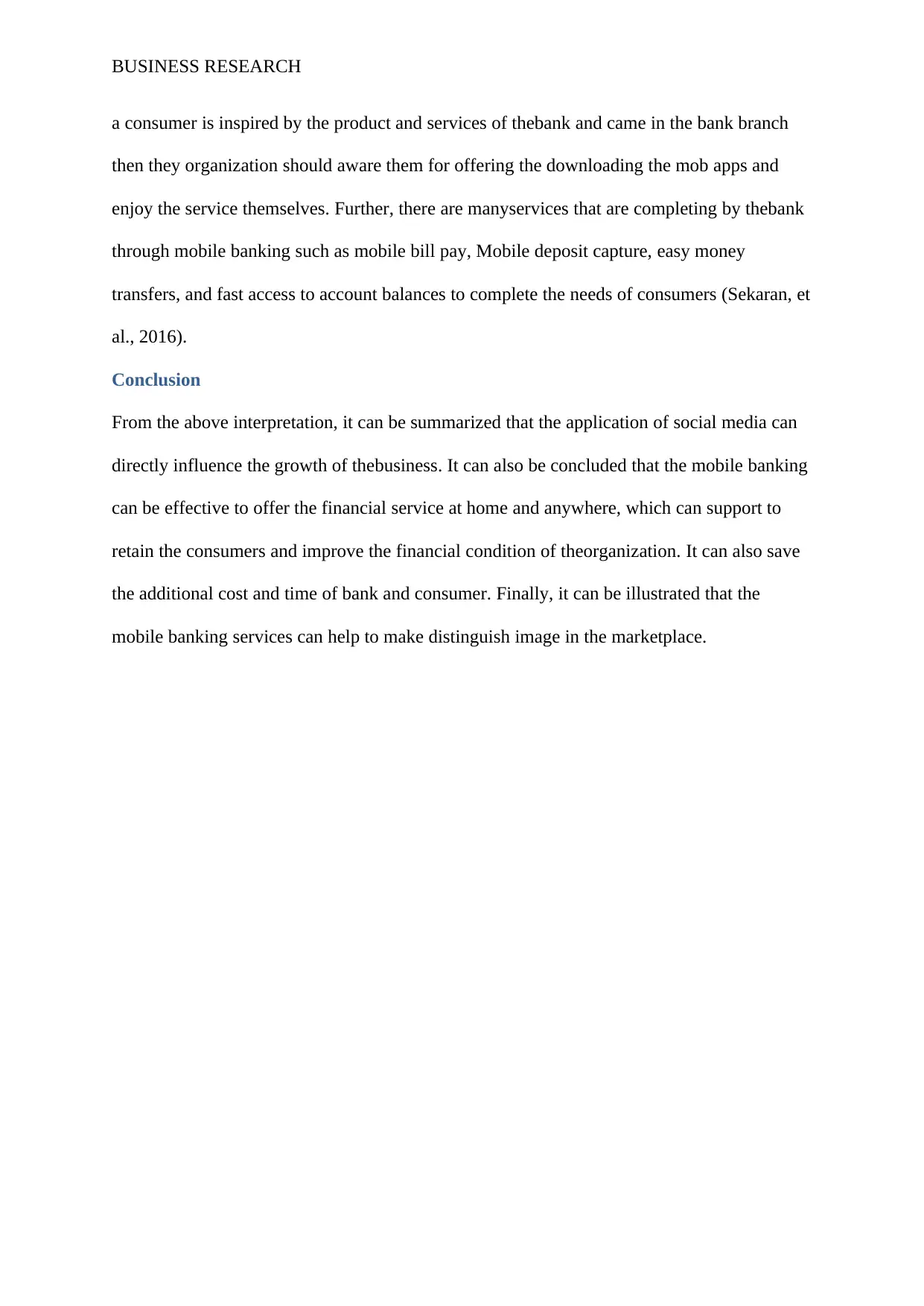
BUSINESS RESEARCH
a consumer is inspired by the product and services of thebank and came in the bank branch
then they organization should aware them for offering the downloading the mob apps and
enjoy the service themselves. Further, there are manyservices that are completing by thebank
through mobile banking such as mobile bill pay, Mobile deposit capture, easy money
transfers, and fast access to account balances to complete the needs of consumers (Sekaran, et
al., 2016).
Conclusion
From the above interpretation, it can be summarized that the application of social media can
directly influence the growth of thebusiness. It can also be concluded that the mobile banking
can be effective to offer the financial service at home and anywhere, which can support to
retain the consumers and improve the financial condition of theorganization. It can also save
the additional cost and time of bank and consumer. Finally, it can be illustrated that the
mobile banking services can help to make distinguish image in the marketplace.
a consumer is inspired by the product and services of thebank and came in the bank branch
then they organization should aware them for offering the downloading the mob apps and
enjoy the service themselves. Further, there are manyservices that are completing by thebank
through mobile banking such as mobile bill pay, Mobile deposit capture, easy money
transfers, and fast access to account balances to complete the needs of consumers (Sekaran, et
al., 2016).
Conclusion
From the above interpretation, it can be summarized that the application of social media can
directly influence the growth of thebusiness. It can also be concluded that the mobile banking
can be effective to offer the financial service at home and anywhere, which can support to
retain the consumers and improve the financial condition of theorganization. It can also save
the additional cost and time of bank and consumer. Finally, it can be illustrated that the
mobile banking services can help to make distinguish image in the marketplace.
Secure Best Marks with AI Grader
Need help grading? Try our AI Grader for instant feedback on your assignments.

BUSINESS RESEARCH
References
Al-Alak, B. A. (2014) ‘Impact of marketing activities on relationship quality in the Malaysian
banking sector’, Journal of Retailing and Consumer Services, 21(3), pp. 347-356.
Amin, M., Rezaei, S., andAbolghasemi, M. (2014) ‘User satisfaction with mobile websites:
the impact of perceived usefulness (PU), perceived ease of use (PEOU) and trust’, Nankai
Business Review International, 5(3), pp. 258-274.
Arvidsson, N. (2014) ‘Consumer attitudes on mobile payment services–results from a proof
of concept test’, International Journal of Bank Marketing, 32(2), pp. 150-170.
Bryman, A., and Bell, E. (2015) Business research methods. USA: Oxford University Press.
Chuah, H. W., Marimuthu, M., andRamayah, T. (2014) ‘The effect of perceived value on the
loyalty of Generation Y mobile internet subscribers: A proposed conceptual
framework’, Procedia-Social and Behavioral Sciences, 130, pp. 532-541.
Giannakis-Bompolis, C., andBoutsouki, C. (2014) ‘Customer relationship management in the
era of social web and social customer: an investigation of customer engagement in the Greek
retail banking sector’, Procedia-Social and Behavioral Sciences, 148, pp. 67-78.
Kandampully, J., Zhang, T., andBilgihan, A. (2015) ‘Customer loyalty: a review and future
directions with a special focus on the hospitality industry’, International Journal of
Contemporary Hospitality Management, 27(3), pp. 379-414.
Kaura, V., Durga Prasad, C. S., and Sharma, S. (2015) ‘Service quality, service convenience,
price and fairness, customer loyalty, and the mediating role of customer
satisfaction’, International Journal of Bank Marketing, 33(4), pp. 404-422.
Keiningham, T., Gupta, S., Aksoy, L., andBuoye, A. (2014) ‘The high price of customer
satisfaction’, MIT Sloan Management Review, 55(3), p. 37.
References
Al-Alak, B. A. (2014) ‘Impact of marketing activities on relationship quality in the Malaysian
banking sector’, Journal of Retailing and Consumer Services, 21(3), pp. 347-356.
Amin, M., Rezaei, S., andAbolghasemi, M. (2014) ‘User satisfaction with mobile websites:
the impact of perceived usefulness (PU), perceived ease of use (PEOU) and trust’, Nankai
Business Review International, 5(3), pp. 258-274.
Arvidsson, N. (2014) ‘Consumer attitudes on mobile payment services–results from a proof
of concept test’, International Journal of Bank Marketing, 32(2), pp. 150-170.
Bryman, A., and Bell, E. (2015) Business research methods. USA: Oxford University Press.
Chuah, H. W., Marimuthu, M., andRamayah, T. (2014) ‘The effect of perceived value on the
loyalty of Generation Y mobile internet subscribers: A proposed conceptual
framework’, Procedia-Social and Behavioral Sciences, 130, pp. 532-541.
Giannakis-Bompolis, C., andBoutsouki, C. (2014) ‘Customer relationship management in the
era of social web and social customer: an investigation of customer engagement in the Greek
retail banking sector’, Procedia-Social and Behavioral Sciences, 148, pp. 67-78.
Kandampully, J., Zhang, T., andBilgihan, A. (2015) ‘Customer loyalty: a review and future
directions with a special focus on the hospitality industry’, International Journal of
Contemporary Hospitality Management, 27(3), pp. 379-414.
Kaura, V., Durga Prasad, C. S., and Sharma, S. (2015) ‘Service quality, service convenience,
price and fairness, customer loyalty, and the mediating role of customer
satisfaction’, International Journal of Bank Marketing, 33(4), pp. 404-422.
Keiningham, T., Gupta, S., Aksoy, L., andBuoye, A. (2014) ‘The high price of customer
satisfaction’, MIT Sloan Management Review, 55(3), p. 37.
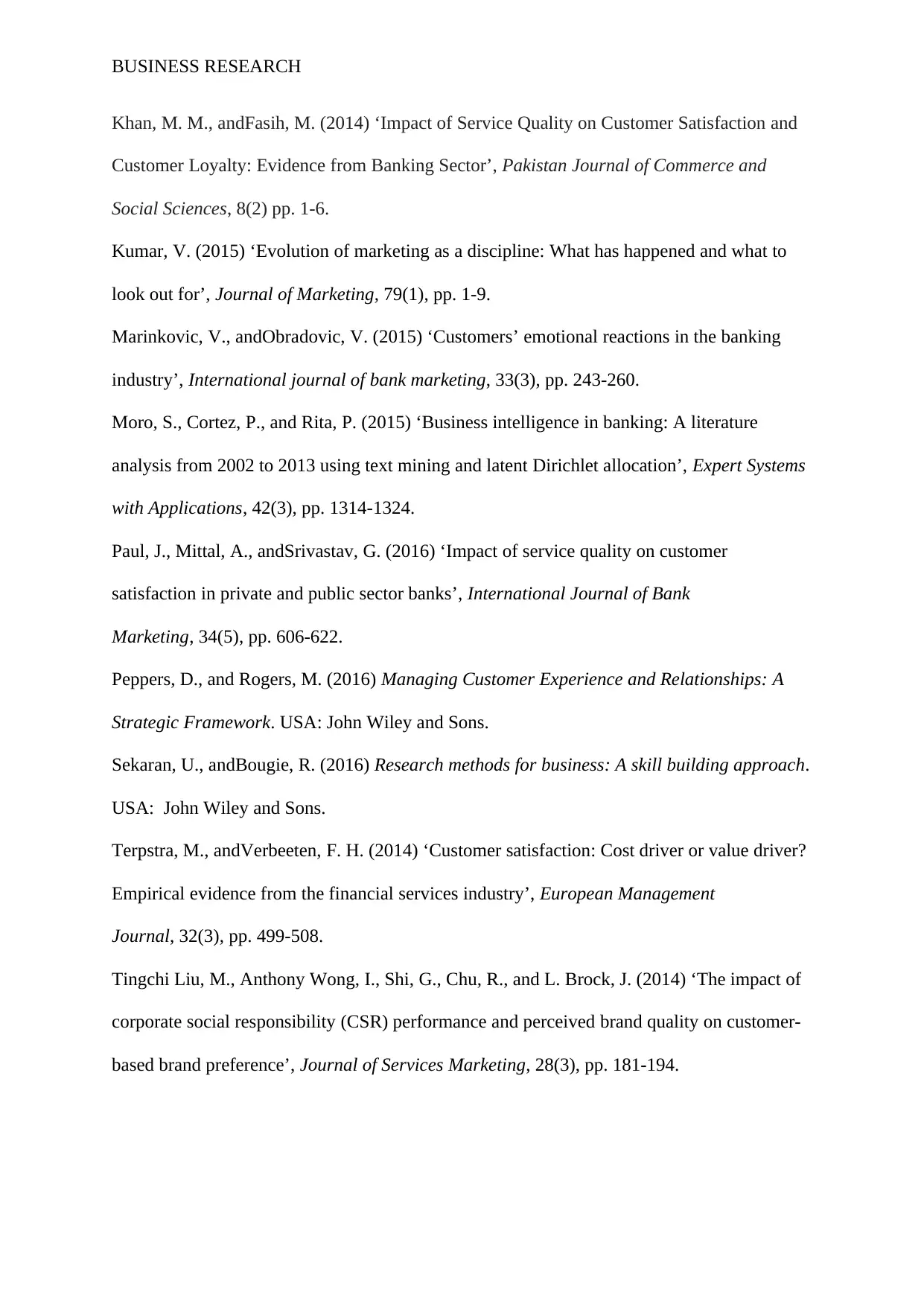
BUSINESS RESEARCH
Khan, M. M., andFasih, M. (2014) ‘Impact of Service Quality on Customer Satisfaction and
Customer Loyalty: Evidence from Banking Sector’, Pakistan Journal of Commerce and
Social Sciences, 8(2) pp. 1-6.
Kumar, V. (2015) ‘Evolution of marketing as a discipline: What has happened and what to
look out for’, Journal of Marketing, 79(1), pp. 1-9.
Marinkovic, V., andObradovic, V. (2015) ‘Customers’ emotional reactions in the banking
industry’, International journal of bank marketing, 33(3), pp. 243-260.
Moro, S., Cortez, P., and Rita, P. (2015) ‘Business intelligence in banking: A literature
analysis from 2002 to 2013 using text mining and latent Dirichlet allocation’, Expert Systems
with Applications, 42(3), pp. 1314-1324.
Paul, J., Mittal, A., andSrivastav, G. (2016) ‘Impact of service quality on customer
satisfaction in private and public sector banks’, International Journal of Bank
Marketing, 34(5), pp. 606-622.
Peppers, D., and Rogers, M. (2016) Managing Customer Experience and Relationships: A
Strategic Framework. USA: John Wiley and Sons.
Sekaran, U., andBougie, R. (2016) Research methods for business: A skill building approach.
USA: John Wiley and Sons.
Terpstra, M., andVerbeeten, F. H. (2014) ‘Customer satisfaction: Cost driver or value driver?
Empirical evidence from the financial services industry’, European Management
Journal, 32(3), pp. 499-508.
Tingchi Liu, M., Anthony Wong, I., Shi, G., Chu, R., and L. Brock, J. (2014) ‘The impact of
corporate social responsibility (CSR) performance and perceived brand quality on customer-
based brand preference’, Journal of Services Marketing, 28(3), pp. 181-194.
Khan, M. M., andFasih, M. (2014) ‘Impact of Service Quality on Customer Satisfaction and
Customer Loyalty: Evidence from Banking Sector’, Pakistan Journal of Commerce and
Social Sciences, 8(2) pp. 1-6.
Kumar, V. (2015) ‘Evolution of marketing as a discipline: What has happened and what to
look out for’, Journal of Marketing, 79(1), pp. 1-9.
Marinkovic, V., andObradovic, V. (2015) ‘Customers’ emotional reactions in the banking
industry’, International journal of bank marketing, 33(3), pp. 243-260.
Moro, S., Cortez, P., and Rita, P. (2015) ‘Business intelligence in banking: A literature
analysis from 2002 to 2013 using text mining and latent Dirichlet allocation’, Expert Systems
with Applications, 42(3), pp. 1314-1324.
Paul, J., Mittal, A., andSrivastav, G. (2016) ‘Impact of service quality on customer
satisfaction in private and public sector banks’, International Journal of Bank
Marketing, 34(5), pp. 606-622.
Peppers, D., and Rogers, M. (2016) Managing Customer Experience and Relationships: A
Strategic Framework. USA: John Wiley and Sons.
Sekaran, U., andBougie, R. (2016) Research methods for business: A skill building approach.
USA: John Wiley and Sons.
Terpstra, M., andVerbeeten, F. H. (2014) ‘Customer satisfaction: Cost driver or value driver?
Empirical evidence from the financial services industry’, European Management
Journal, 32(3), pp. 499-508.
Tingchi Liu, M., Anthony Wong, I., Shi, G., Chu, R., and L. Brock, J. (2014) ‘The impact of
corporate social responsibility (CSR) performance and perceived brand quality on customer-
based brand preference’, Journal of Services Marketing, 28(3), pp. 181-194.
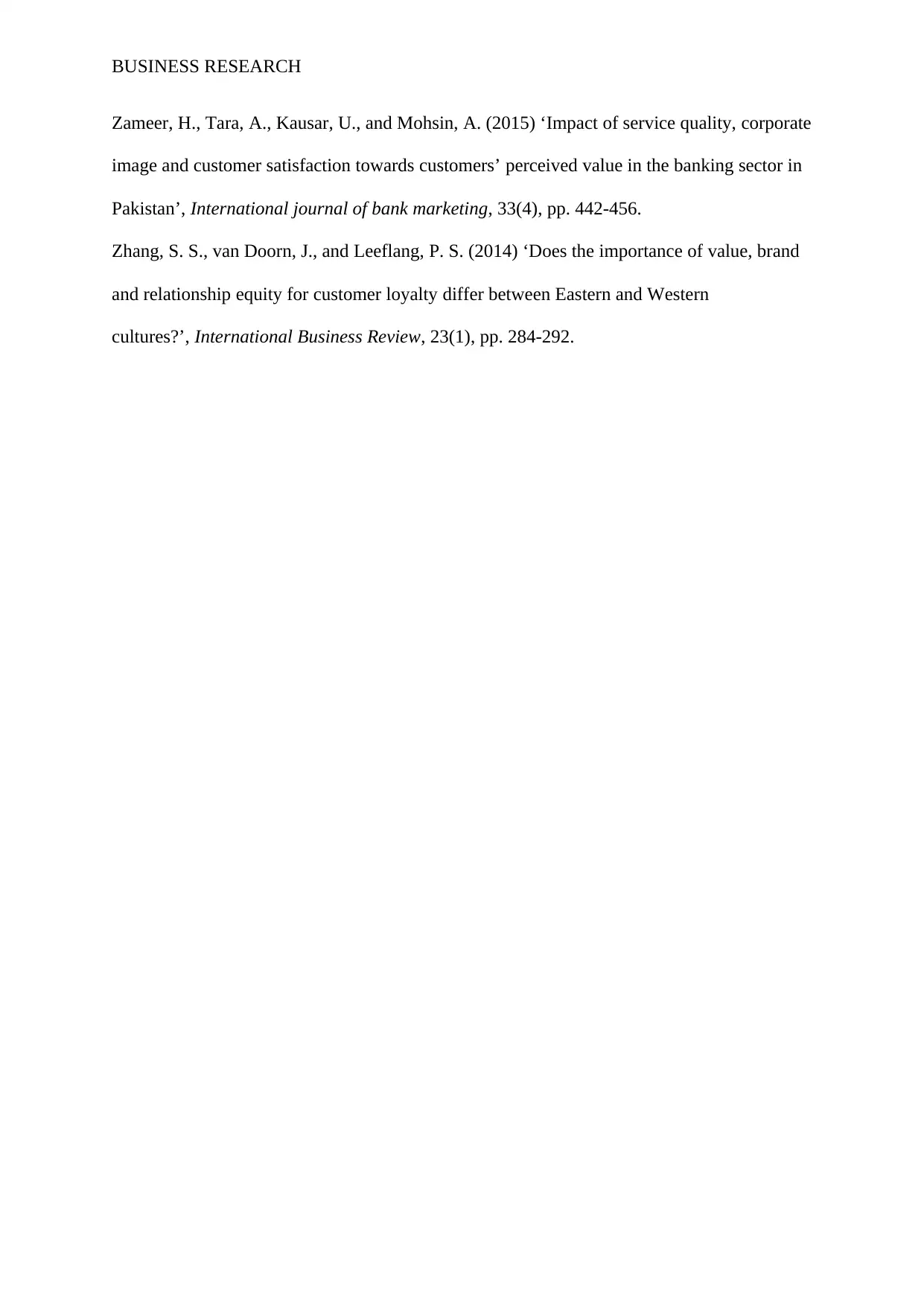
BUSINESS RESEARCH
Zameer, H., Tara, A., Kausar, U., and Mohsin, A. (2015) ‘Impact of service quality, corporate
image and customer satisfaction towards customers’ perceived value in the banking sector in
Pakistan’, International journal of bank marketing, 33(4), pp. 442-456.
Zhang, S. S., van Doorn, J., and Leeflang, P. S. (2014) ‘Does the importance of value, brand
and relationship equity for customer loyalty differ between Eastern and Western
cultures?’, International Business Review, 23(1), pp. 284-292.
Zameer, H., Tara, A., Kausar, U., and Mohsin, A. (2015) ‘Impact of service quality, corporate
image and customer satisfaction towards customers’ perceived value in the banking sector in
Pakistan’, International journal of bank marketing, 33(4), pp. 442-456.
Zhang, S. S., van Doorn, J., and Leeflang, P. S. (2014) ‘Does the importance of value, brand
and relationship equity for customer loyalty differ between Eastern and Western
cultures?’, International Business Review, 23(1), pp. 284-292.
1 out of 13
Related Documents
Your All-in-One AI-Powered Toolkit for Academic Success.
+13062052269
info@desklib.com
Available 24*7 on WhatsApp / Email
![[object Object]](/_next/static/media/star-bottom.7253800d.svg)
Unlock your academic potential
© 2024 | Zucol Services PVT LTD | All rights reserved.





